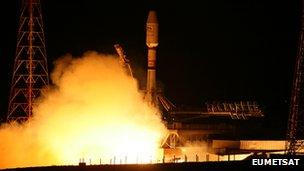Lift-off for Europe's Metop weather satellite
- Published

Metop's Soyuz rocket leaves the launch pad at Baikonur, Kazakhstan
A European satellite that will acquire data critical for weather forecasters has launched from Baikonur, Kazakhstan.
A Soyuz rocket carried for a flight to orbit that lasted just over the hour.
The spacecraft will ensure there is continuity of observations following Metop-A, which was launched in 2006.
The computer models that provide our daily forecasts have come to rely heavily on this satellite's data.
Metop-A's information now makes the single largest contribution to the accuracy of the one-day look-ahead.
"Now, you could not imagine predicting the weather without satellites," said Dr Alain Ratier, the director general of Eumetsat, the intergovernmental organisation charged with running Europe's weather platforms.
"Based on scientific studies run by the main met services in Europe, it can be shown that 25% of the performance of 24-hour forecasts can be explained by the input data of the Metop class," he told 成人快手 News.
Lift-off from Baikonur occurred at 22:29 local time (16:29 GMT; 17:29 BST). The Soyuz mission was declared a success after the rocket's upper-stage ejected Metop-B at an altitude just over 800km.
Controllers immediately acquired a signal from the satellite and began the process of deployment of the solar array.
Metop-A and B will fly around the globe from pole to pole in tandem, passing over the equator at 0930 local lime.
Their formation operation will enable their observations to be cross-calibrated.
Scientists can then be satisfied by the quality of the new data and reassured of its continuing availability as Metop-A, which is now operating beyond its design lifetime, begins to fail.
Dr Florence Rabier: "As a single satellite, Metop has had the most impact on weather prediction"
Metop-B carries the exact same instruments as the A platform.
This suite of sensors looks down through the different layers in the atmosphere to record a wide range of variables.
These include measurements of temperature and humidity, cloud properties, and an array of gases such as ozone, carbon dioxide, methane and nitrogen dioxide.
Metop will also monitor sea surface temperature, snow and ice cover, and the state of land vegetation. It has even found important roles in watching for fires on the ground and the spread of volcanic ash in the air.
The Metop satellite looks down through the different layers in the atmosphere
The Metop system is run in unison with the Americans, who have their own polar-orbiting satellites. This space information complements that from balloons, surface stations and aeroplanes (and not forgetting other types of satellite).
Dr Alain Ratier: "Now, you could not imagine predicting the weather without satellites"
All of this data is fed into the numerical models that produce weather forecasts several hours to 10 days ahead, but Metop's input is recognised to have by far the biggest impact on what has been a steady improvement year by year.
"The forecasts have improved tremendously over the past decades," said Dr Florence Rabier from the numerical weather prediction group at Meteo France.
"We say that we gain in predictability about a day per decade, which means that every decade the four-day forecast is now as accurate as the three-day forecast was 10 years ago."
Metop-B is the second in a three-satellite series
Europe has a third satellite already built and in store - Metop-C. Assuming the B platform continues to work as expected, no decision will be made to put up this C satellite until later in the decade.
However, a determination is required very soon on what to do about a Metop follow-on project.
The so-called Eumetsat Polar System, Second Generation (EPS-SG) is expected to cost just shy of 3bn euros.
Although its first spacecraft will likely not be needed until the early 2020s, the complexity of the systems involved means R&D work must get under way as soon as possible.
Eumetsat will engage the European Space Agency (Esa) for this. The member states of Esa are due to meet in November to approve the arrangements and funding for the R&D on EPS-SG.
Eumetsat's own members also still need to approve the overall programme.
Jonathan.Amos-INTERNET@bbc.co.uk and follow me on Twitter:
- Published14 September 2012
- Published6 July 2012
- Published15 March 2012
- Published16 November 2011
- Published28 October 2011
- Published25 February 2011